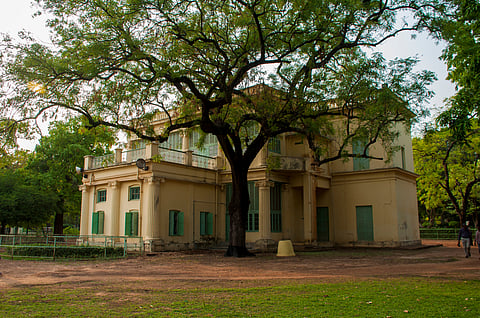Tagore's Santiniketan Joins UNESCO World Heritage List
Santiniketan, a quaint small town in West Bengal, where revered poet and philosopher Rabindranath Tagore laid the foundation of Visva Bharati over a century ago, has earned its rightful place on the prestigious UNESCO World Heritage list. This momentous occasion was celebrated during the 45th Session of the World Heritage Committee, held in Saudi Arabia. It is one of the two sites in India that has been included in the UNESCO World Heritage list 2023.
A Visionary's Legacy
Founded in 1901 by the illustrious poet and philosopher Rabindranath Tagore, Santiniketan stands as a testament to his vision of a harmonious world rooted in ancient Indian traditions. Originally established as a residential school and an art centre, Santiniketan was conceived as a place where art, culture, and education could flourish, transcending the boundaries of religion and culture.
The Genesis Of Santiniketan
The story of Santiniketan's birth is woven into the Tagore family's history. In 1862, Rabindranath Tagore's father, Debendranath Tagore, stumbled upon this enchanting landscape during a boat journey to Raipur. Struck by the captivating beauty of red soil and lush paddy fields, he decided to establish an 'Ashram' or hermitage. The house he built, known as Santiniketan, still stands today, serving as a living testament to the town's enduring legacy.
The Birth of Visva Bharati
In 1921, Santiniketan evolved into a "world university," bearing the name "Visva Bharati." This transformation reflected the ideals of global unity and the shared essence of humanity. Tagore's creation was not merely an educational institution but a sanctuary for knowledge and culture, where individuals from diverse backgrounds could come together to learn and create.
Originally named Bhubadanga, Santiniketan underwent a transformation as Debendranath Tagore found solace in the serene surroundings. In 1901, Rabindranath Tagore expanded upon his father's vision, establishing a school based on the "Brahmachary Ashram" model, reminiscent of India's ancient Gurukul system. Over time, this school evolved into Visva Bharati, a vibrant university that Tagore described as a place where "the world makes a home in the nest."
A Unique Architectural Expression
Santiniketan's architecture sets it apart from the prevailing British colonial and European modernist styles of the early 20th century. Instead, it represents a distinct path toward pan-Asian modernity. It draws inspiration from ancient, medieval, and folk traditions spanning the Asian continent. The result is a captivating blend of architectural elements that resonate with history and cultural richness.
A Proud Moment For India
Prime Minister Narendra Modi hailed the inclusion of Santiniketan in the UNESCO World Heritage Sites list as a source of pride for all Indians. This recognition elevates Santiniketan's status as a global treasure, acknowledging its profound cultural and historical significance.
West Bengal Chief Minister Mamata Banerjee expressed her delight at Santiniketan's UNESCO recognition, acknowledging the enduring support of the people of Bengal. Over the past 12 years, the government has made substantial contributions to enhance the infrastructure of this hallowed place. Santiniketan's newfound global acclaim resonates with the teachings of Tagore, emphasising fraternity and unity.
A Long-Awaited Honour
India's efforts to secure UNESCO recognition for Santiniketan date back to 2010. The Archaeological Survey of India (ASI) has played a pivotal role in restoring and preserving various structures within Santiniketan, including Griha, Konark, Upasana Griha Purba, and Paschim Toran.
Places To Visit Near Santiniketan
Santiniketan and its environs offer tourists a multifaceted array of cultural, educational, and natural attractions. At the heart of this quaint town lies Visva-Bharati University, founded by Nobel laureate Rabindranath Tagore, whose legacy permeates the town's ethos. The university campus is a captivating destination, housing Kala Bhavana, an esteemed art school with vibrant galleries showcasing diverse art forms. Beyond academia, Santiniketan is celebrated for its annual Khoai Mela, an open-air fair set amidst the intriguing geological formations of Khoai, where visitors can shop for handcrafted goods and immerse themselves in the local culture. The nearby Sriniketan complements this cultural tapestry, focusing on rural development and traditional crafts. Nature enthusiasts can explore Ballavpur Wildlife Sanctuary and its avian and animal residents, while those seeking spiritual experiences can visit temples like Kankalitala and Nalateswari. Santiniketan thus beckons travellers with its rich heritage, artistic ambience, and harmonious blend of culture and nature.
Getting There
To reach Santiniketan, one can opt for various transportation methods. The town is accessible by air through the Netaji Subhas Chandra Bose International Airport in Kolkata, followed by a 4-5 hour road journey. Bolpur Shantiniketan Railway Station, situated in the town, offers a convenient rail option. Visitors can drive or take a taxi by road, following NH114 or SH6 from Kolkata to cover the 215-kilometer distance. Regular bus services also connect Kolkata and other West Bengal cities to Bolpur, from where local taxis or auto-rickshaws can be hired for the final leg of the journey to Santiniketan.
Where To Stay
Santiniketan offers diverse accommodation options to suit varying budgets. Budget-conscious travellers can find comfort in West Bengal Tourism Development Corporation's tourist lodges, youth hostels, or local guesthouses and homestays. Mid-range choices encompass hotels and resorts such as Rangamati Garden Resort and BnR Hotel, offering a balance between affordability and amenities. For those seeking luxury, nearby cities like Kolkata provide upscale accommodations, as Santiniketan primarily focuses on budget and mid-range options.


